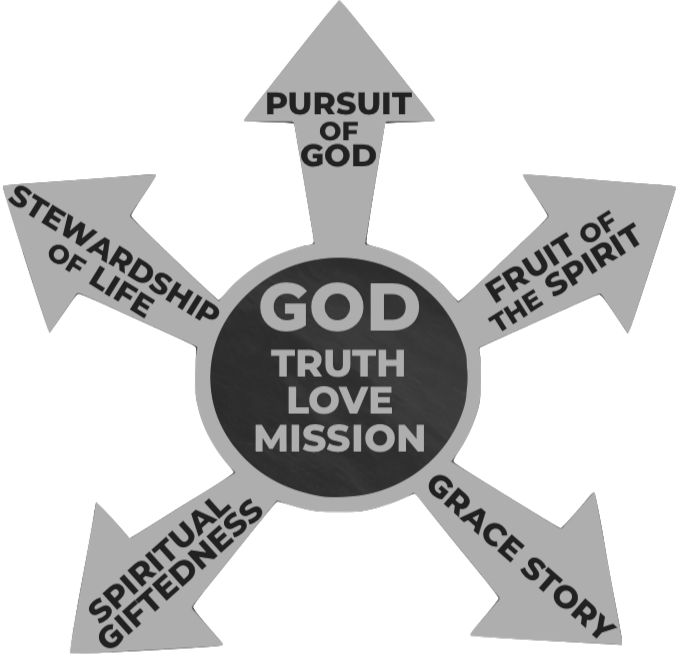Circle of Accountability | Acts 1:8
Outcomes
The primary and most important task of the church is to see that people are growing in their relationship with God the Father. The second task of the church is to strengthen and enable believers to represent God. Our hope and prayer is that ALL of Christ’s people grow in relationship and representation of Him. An essential part of our mission at Missio Church is to equip people to live faithful lives of worship. What does that mean? What does it look like to live a faithful life? It is very helpful for us to work from a common answer to these questions. Therefore, we often refer to our “Five Outcomes of Discipleship” to describe what a faithful life of worship looks like
Over six weeks, we want to survey each of these discipleship outcomes and explore how these are displayed in a geography. Or to say it another way, we hope to answer these two questions:
What does Biblical success look like for the people of God?
What does Biblical success look like in our place and in the world?
PURSUIT OF GOD — A detailed knowledge and understanding of God that comes from pursuing Him as our greatest treasure.
FRUIT OF THE SPIRIT — The acting presence of the Holy Spirit in the life of the Church that demonstrates the character of God and distinguishes His people from an unbelieving world.
SPIRITUAL GIFTEDNESS — Discovering who God has uniquely made us to be and surrendering ourselves to His purposes, serving both the Church and the world with the gifts He has given us.
GRACE STORY — Embracing the fullness of the Gospel and being transformed by it in such a way that we desire to live it out and share it with others.
STEWARDSHIP OF LIFE— Faithfully using everything that God has entrusted us to reflect His glory.
CIRCLE OF ACCOUNTABILITY— Asking the Holy Spirit to give our local congregations a geographical sphere around us in which we can empower and mobilize ALL our resources to guarantee that every man, woman, and child can have the opportunity to hear, understand, and accept or reject Jesus as Lord and Savior.
Stewardship of Life | Matthew 25:14-30
Grace Story | 2 Corinthians 5:17-21
Spiritual Giftedness | 1 Corinthians 12:1-31
Fruit of the Spirit | Galatians 5:22-23
Pursuit of God | Psalm 119:9-16
Matthew 25:1-13
Isaiah 60:1-22
Advent 2022 | From Darkness to Glorious Light
Advent 2022: From Darkness to Glorious Light | A Study of Isaiah 59-60
The Oxford English Dictionary defines the term advent as the arrival of a notable person, thing, or event. Of course, as it pertains to Christianity, the term advent is associated with the arrival of the Christ—both his historic birth and his anticipated return. It is these two advents which bookend the current moment of redemptive history and serve as the very foundation of theChristian faith.
When we speak of the advent of Christ, we are, in essence, speaking of divine intervention. We are speaking of God interrupting humanity’s sin with His redemptive purposes. We are speaking of the deepest darkness being overwhelmed by the glorious light of Christ.
Long before the birth of Christ, and with both advents in view, Isaiah 59 & 60 paint a compelling picture of God taking decisive action in order to rescue people from the domain of darkness and bring them into the eternal Kingdom of His beloved Son. These two chapters begin with incredible darkness. They end with glorious light. And in the middle? A central figure, clothed in righteousness, salvation, vengeance, and Zeal. A Redeemer who will stand as covenant mediator between God and His people forever. He is none other than Jesus the Christ.
“Arise, shine, for your light has come, and the glory of the LORD has risen upon you.” — Isaiah 60:1
Week 1: Darkness: Evil and Oppression (59:1-13)
The infectious nature of sin is on full display as Israel is found to be as guilty as their oppressors. The universal implication is that mankind’s iniquity has separated him from God. With no intervention, there is no prospect for peace with our Creator, as our sins testify against us and we are helpless to save ourselves.
Week 2: Decisive Intervention: Judgment and Redemption (59:14-21)
Displeased with the situation, and knowing that no man can effectively intercede for himself, God decisively initiates redemptive action. A central figure emerges, girded for battle with righteousness, salvation, vengeance, and zeal. He will bring wrath to his adversaries, but to the repentant, he will bring redemption. Furthermore, he will stand as Covenant Mediator between God and His redeemed people for all eternity.
Week 3: Glorious Light: Zion’s future glory (60:1-22)
Isaiah 60:1-22 can have none other than Christ’s second advent in view as it depicts “God’s rule, fully realized…as perfect and permanent as God himself.” * A glorious picture of God’s triumphant kingdom, and the consummation of all of God’s redemptive purposes since Genesis chapter 3. From darkness to glorious light.
* Barry G. Webb, “The Message of Isaiah” 233
Isaiah 59:14-21
Isaiah 59:1-13
Creation & Promise | Studies in Genesis
Genesis literally means origin or beginning. It is the first book, the beginning, of the Bible. It details both the beginnings of history and the beginnings of the people the LORD was creating for himself. In the opening chapters we learn of the creation of the world and everything in it. Though Genesis features God’s creation it also describes the corruption of this creation through sin. However, God’s purposes would not be thwarted. He promised to redeem His people and His creation through the seed of Eve who would crush the serpent and his work. (Gen 3.15). Through this seed all the nations of the earth would be blessed (Gen 12.3). Genesis is the historical development and outworking of that promise despite obstacles that seemed to stand in the way. When we arrive at the New Testament we understand this promise would ultimately be realized in the promised seed Christ Jesus. In pointing forward to the Seed, Genesis lays the groundwork for understanding the rest of Scripture and looking forward to Christ.
BOOK WITHIN A BOOK
It really is difficult to isolate Genesis from the four books that follow—Exodus, Leviticus, Numbers, and Deuteronomy. The history and storyline, along with the common authorship of Moses, tie these 5 books together. Together they comprise the Torah or what we call often call the Pentateuch.
AUTHORSHIP
While Genesis does not explicitly identify its author, we have every reason to believe that these words were penned by Moses. Throughout the Torah we read of God asking Moses to record events, laws, and even songs. These books were later identified as the Book of Moses. Both Jesus (Mt 19.7) as well as other religious leaders (Mt 22.24) simply assumed Moses was the author.
WHEN
The book of Genesis was likely written between Moses leading the people of God out of Egypt and his death. Genesis could have been composed around 1450 B.C., depending on the date of Exodus.
THE BIG PICTURE
It is often useful to understand the big picture of a book before studying the individual parts. Genesis is no exception. Genesis has a unique feature that may provide a clue to its meaning. The word תוֹלְד֧וֹת is used 11 times. It is usually translated “these are the generations of” or “this is the account of.” It is used in 2.4, 5.1, 6.9, 10.1, 11.10, 27, 25.12; 19; 36.1, 9. As a result many read Genesis as a 10 episode story with a prologue.
Others simply divide it into 2 larger sections split between 1.1-11.32 and 12.1-50.26. Derek Kidner has advocated this view in the following outline:
A. THE PRIMEVAL HISTORY (chapters 1–11)
1. The story of creation (1:1–2:3)
2. The probation and fall of man (2:4–3:24)
3. Man under sin and death (4:1–6:8)
4. The world under judgment (6:9–8:14)
5. Renewal and repeopling (8:15–10:32)
6. End and beginning: Babel and Canaan (11:1–32)
B. THE CHOSEN FAMILY (chapters 12–50)
1. Abram under call and promise (chapters 12–20)
2. Isaac and the further tests of faith (chapters 21–26)
3. Jacob and the emergence of Israel (chapters 27–36)
4. Joseph and the migration to Egypt (chapters 37–50)
___________________________________
1Derek Kidner, Genesis: An Introduction and Commentary, vol. 1, Tyndale Old Testament Commentaries (Downers Grove, IL: InterVarsity Press, 1967), 45.


